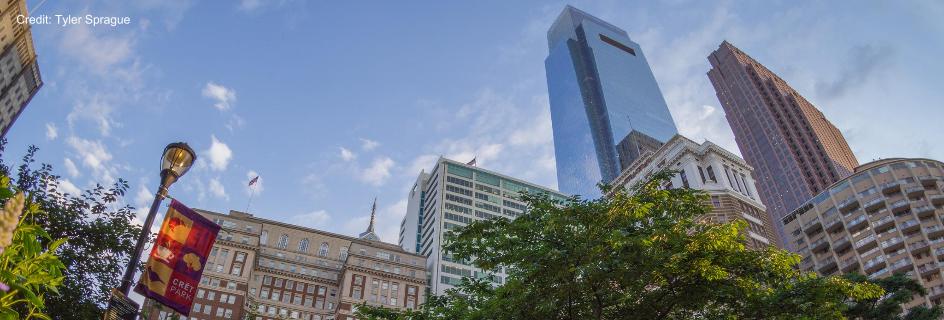- About GPA
- Global Events
- GLOBAL NEWS FROM PHL
- Global Directory
- World Heritage City
- Sustainable Development Goals (SDGs)
- Global Philadelphia Role on Sustainable Development Goals
- Completed Sustainable Development Goals
- SDG#1: No Poverty
- SDG #2: Zero Hunger
- SDG#3: Good Health & Well-Being
- SDG#4: Quality Education
- SDG#5: Gender Equality
- SDG#6: Clean Water & Sanitation
- SDG#7: Affordable and Clean Energy
- SDG #8: Decent Work and Economic Growth
- SDG #9: Industry, Innovation, and Infrastructure
- SDG#10: Reduced Inequalities
- SDG#11: Sustainable Cities and Communities
- SDG#16: Peace, Justice and Strong Institutions
- SDG#17: Partnerships for the Goals
- Press
Home ›
Building Our Past and Present -- A Look at Carpenters’ Hall
Posted on May 8, 2020

So if we looked, really looked, through the doorways of some of Philadelphia’s 67 National Historic Landmarks (NHLs), what would we find? What could we imagine?
Suppose we try this with Carpenters’ Hall (CH), located at 320 Chestnut Street near Independence National Historical Park. CH was built in 1770 as a headquarters for the Carpenters Company of the City and County of Philadelphia (CCP).
In addition to the members of CCP being some of the city’s major leaders during the colonial and new nation eras, CH also housed major cultural and political activities. Here’s a sample of the history:
- Benjamin Franklin’s Library Company operated in CH in the 1730s
- CCP members directed the construction of the Pennsylvania State House (later known as Independence Hall) in the 1750s
- The First Continental Congress met at CH in September, 1774, instead of the new Pennsylvania State House. Here, delegates from 12 of the American colonies deliberated over the next political steps long before independence
- When the British occupied Philadelphia during the American Revolution, its army used CH as a hospital
- When Philadelphia was the national capital from 1790-1800, new populations moved here from New York City and elsewhere, and CC leaders directed the construction of new residential and commercial buildings
- When the First Bank of the United States opened for business in 1791, CH was its home until it moved into its own building in 1797 at 120 S. 3rd Street
- The Musical Fund Society practiced at CH in the 1820s on a weekly basis
Both the CCP and CH have been involved in major domestic and international matters, events and trends since the colonial era. The Worshipful Company of Carpenters in London served as the model for the CCP and some CCP members were English, so the global reach was clear from the start. CCP members were among the city’s civic, political, and cultural leaders. The First Bank of the United States was involved in many international commercial and financial activities while its directors conducted operations at CH, and the new country's funds were held there during this time.
And now, as we are all adapting to new challenges and ways of communicating with each other, CH is offering new possibilities. For example, CH is hosting a reading program focused on the yellow fever epidemic of the 1790s (Urban Epidemic: Yellow Fever Reading Group Tickets, Multiple Dates) and reminding us that many of its holdings are available online (Carpenters' Company Digital Archive & Museum). We can look forward to CH’s exhibit, Places for the People: WPA Travel Posters, later in the year, offered in collaboration with the Free Library of Philadelphia. As Michael L. Norris, CH’s executive director, offered, “Carpenters’ Hall is an architectural gem and one of Philadelphia’s most significant historical sites. Like all our peers in the cultural community, we are striving to be nimble in these challenging times and to engage the public in appropriate and relevant ways.” We know that to be true!
Possible Activities
Using the image and short chronology included with this article, many ideas for activities may come to mind for families, teachers, students. Here are a few possibilities to get you started:
- If you were sitting on CH’s steps when Philadelphia was still a colonial city, what might you see? Maybe various workers, indentured servants and slaves going about their daily tasks? Or, importers and tradesmen driving their goods around the streets? Local farmers delivering flaxseed for export to England and Ireland to weave into linen? Maybe you can write about what you see, or draw pictures?
- If you were inside CH, what would it look like when the British was using CH as a hospital during the American Revolution?
- What would it sound like inside CH if the Musical Fund Society was practicing? What instruments might the musicians play?
- If you think about the CC leadership and what CC accomplished, what does it make you think about what makes a good civic, cultural, or business leader? What is good civic participation?
- CH was an important meeting place in the colonial and new nation era. How was all of that arrangement different from our time of Zoom meetings?
- How do construction and building trades differ now from the colonial era when the CC was new?
Looking for Additional Resources?







